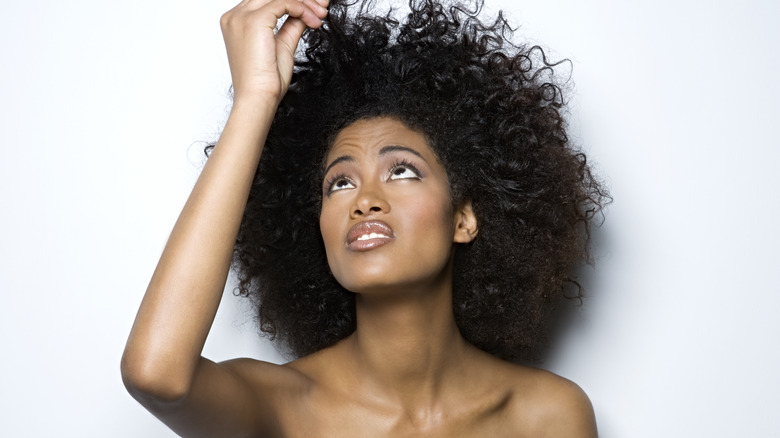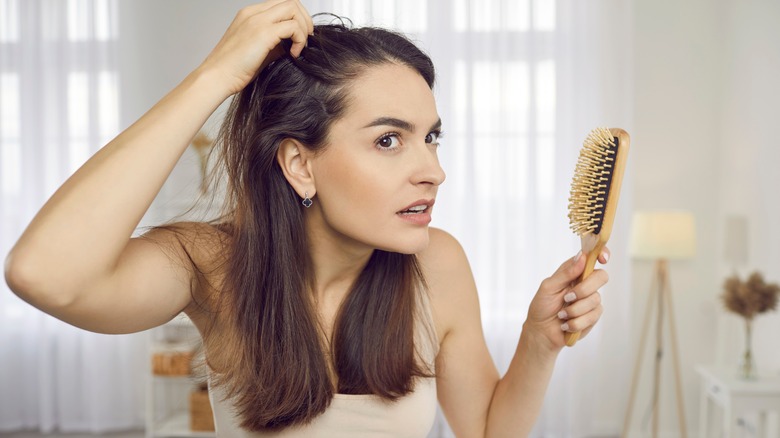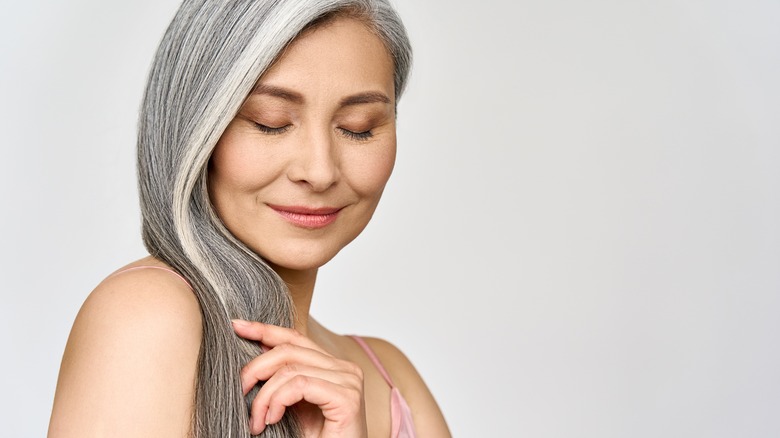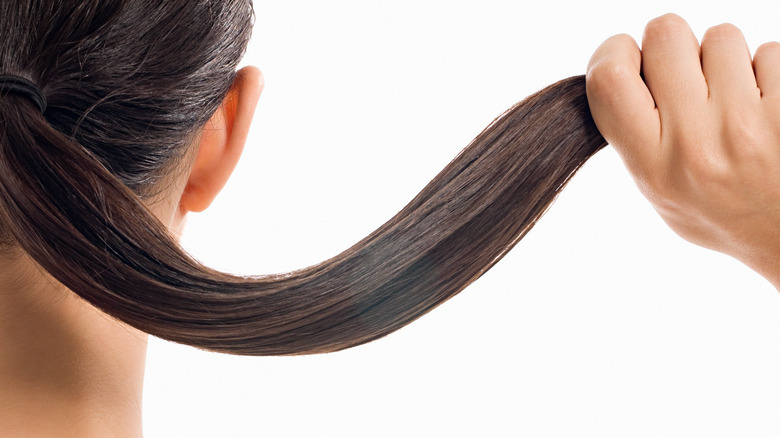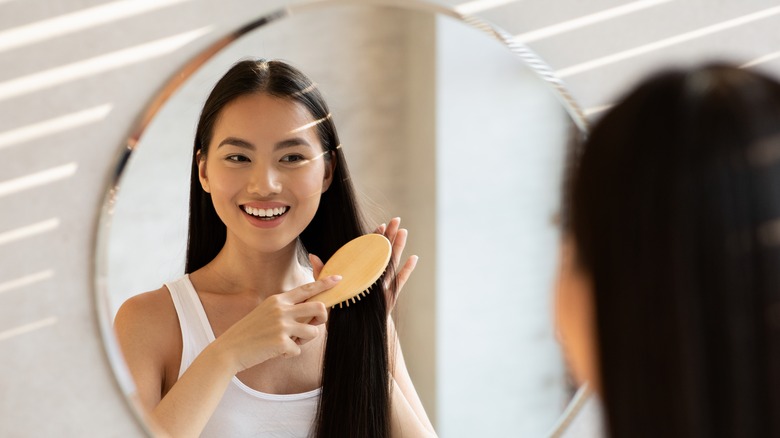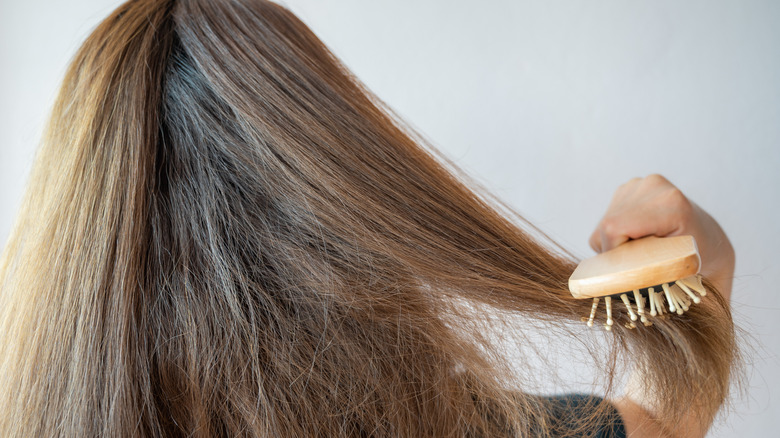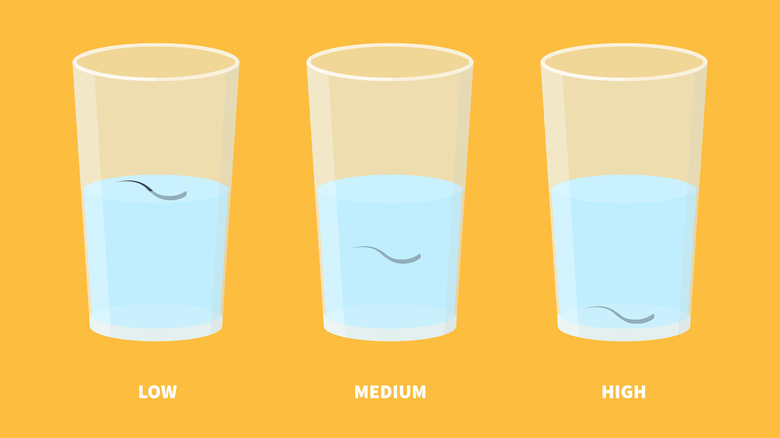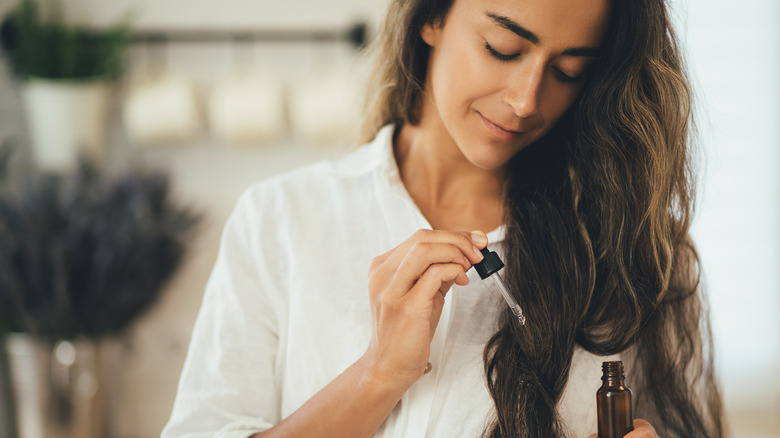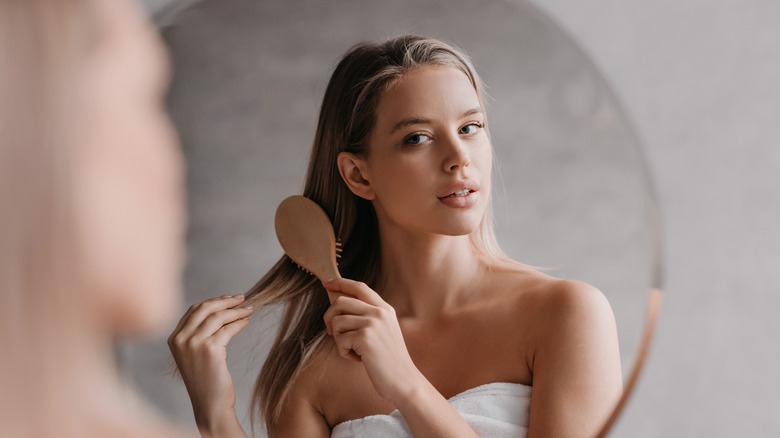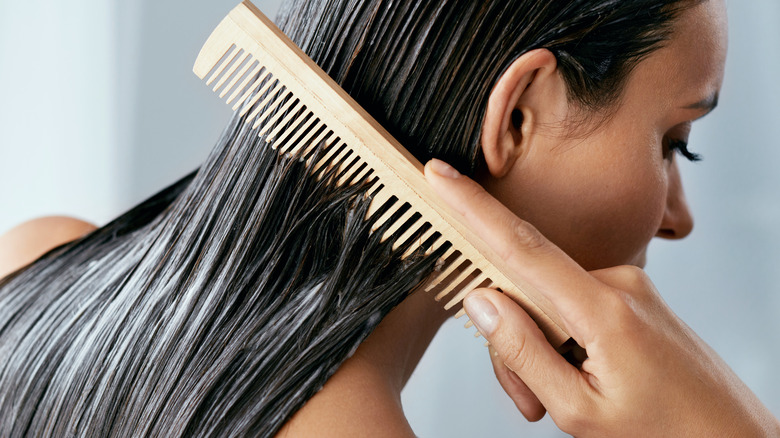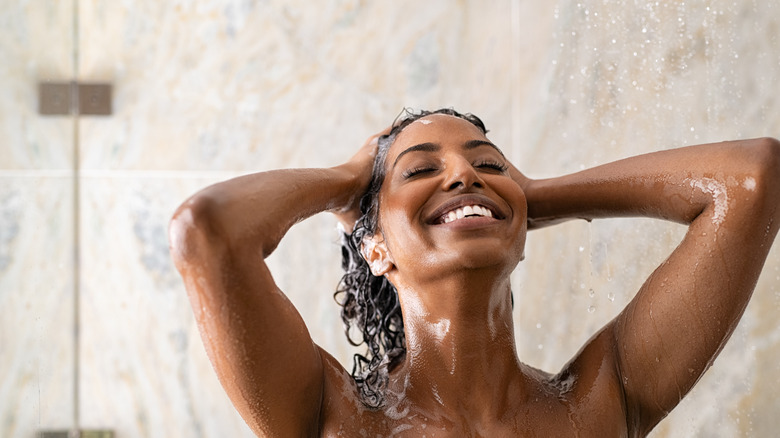Everything You Ever Wanted To Know About Hair Porosity
If you're someone who constantly switches between different hair care products because a lot of them don't seem to work, knowing what kind of porosity your hair has can help you get healthier, stronger, and overall better-looking hair. Of course, a good routine with effective products can do wonders for your hair, but knowing if you're picking the right ones for your type of hair porosity is crucial. You may have seen a viral TikTok hair care product, but just because it worked on someone else doesn't mean it will work on your hair.
"All porosity types need a good shampoo, a conditioner and a hair mask. Followed up with a leave-in conditioner suitable for your hair (liquid or richer)," Rhyme and Reason certified trichologist Angela Onuoha reveals to Refinery29. "High porosity tends to need more protein and more moisture. But it's mostly all about sticking to a simple yet effective and sustainable regimen."
While everyone should know the type of hair porosity they have, those with afro hair can particularly benefit from using the right products. "Hair porosity is particularly important to understand for the afro hair community as this knowledge can be the important dividing factor between not just a bad and good hair day but also prolonged length retention," Paula Francis, founder and co-formulator of vegan hair wellness brand Superfood Lx, tells Refinery29. The hair expert even says that knowing your hair porosity is more important than knowing your hair type. Luckily, we summarized the most important information on hair porosity.
What is hair porosity?
Hair porosity is the ability of your hair to absorb moisture and retain it. Of course, everyone wants to have that luscious, silky, smooth hair that isn't oily but at the same time looks perfectly nourished, and hair porosity certainly has a lot to do with your hair's appearance.
Dr. Isfahan Chambers-Harris, a medical scientist, hair trichologist, and founder of Alodia Hair Care, likes to use a straw metaphor to explain hair porosity. "If you have a straw and put holes in it, you can take in the liquid easily, but you can't retain the liquid. Once you take it out of the liquid, it's all going to run out of the straw," the hair expert explains to Byrdie.
In order to understand hair porosity better, it's important to know that each hair strand consists of three layers: the cuticle, which is the hard protective outside layer made of a bunch of small cuticles overlapping each other; the cortex, which is the thick layer of your hair that contains proteins and pigment; and the medulla, which is the soft part in the hair's center (via Healthline).
What types of hair porosity are there?
Since hair porosity affects your hair in many ways, it's important to know the different types of it. "Porosity can be broken down into three categories: low, normal, and high," founder of Atlanta-based Too Groovy Salon and African Pride brand educator Robin Groover tells Byrdie. "Low porosity hair has cuticles that are bound very close together, normal porosity hair has cuticles that are slightly less bound, and high porosity hair has cuticles that are more widely spread out."
According to the New York Society of Cosmetic Chemists, one can also have a mixture of all three hair porosities, meaning that some strands on the head have low porosity, some have high porosity, and others are normal. However, this is rarely the case. For most people, a majority of their hair will fall into the same category, especially if it's often exposed to heat damage or harsh chemicals.
Hair porosity is also something that can change over the years. Hairstylist and afro-textured hair specialist Jennie Roberts reveals to Refinery29 that she went from low-porosity to high-porosity hair. "My hair used to be really low porosity but as I've gotten older my hair texture has changed and my porosity is much higher which means it holds more water and gets wet very quickly," she tells the outlet.
Why knowing the type of hair porosity you have is so important?
Even though many may not have heard of hair porosity until recently, knowing what type of porosity you have is crucial when it comes to picking the right hair care routine. "[Porosity] is important because when you know the condition of your hair, it will guide you on how to pick out products to either help replenish moisture in your hair or deal with issues of dryness and breakage," Los Angeles-based trichologist and celebrity hairstylist Kari Williams tells Women's Health. "It will also guide you on how you should create your haircare regimen, because having the right balance of moisture in your hair is going to determine its overall health."
Apart from knowing what kind of hair care products you should use, knowing your hair porosity will also help you if you're dying your hair. Per The Shade, porous hair, since it has a damaged and raised cuticle, will absorb that hair color easier, which can lead to it being darker and duller. Because the cuticle is raised, the color can also fade quicker, as the hair strands are unable to retain the color pigment molecules.
Keune notes that dyed, high-porosity hair often looks uneven, which is why using acidic products that will lower the pH level and help close the cuticles is important. This will prevent the color from fading too quickly. On the other hand, low-porosity hair is more difficult to dye, which is why an alkaline product like permanent hair color works much better; the alkalinity opens the cuticle and helps the color reach the inside layers of your hair.
What is low hair porosity and what causes it?
Low-porosity hair takes a long time to dry, shows product build-up very visibly, and takes a longer time to get your hair fully wet when you're washing it. However, this type of hair porosity is rarely caused by the frequent use of chemicals and heat. While some may think that having low-porosity hair means your hair is unhealthy, this isn't the case. "I love to tell people [it's a myth]," Dr. Isfahan Chambers-Harris tells Byrdie. "Low porosity [hair] is actually healthy hair that is not being moisturized correctly. The cuticle layer is intact, but you're not moisturizing it properly, so it becomes dry and tangled."
Per hair specialist Candace Witherspoon, if you have hair with low porosity, it's difficult to moisturize it because the cuticle layer is very tightly laid in the hair and it's not allowing the moisture to penetrate it (via Women's Health).
What is high hair porosity and what causes it?
High-porosity hair tends to look and feel dry, it's usually frizzy and dries quickly. "With high porosity [hair], you can take in water, but you can't retain the water," Dr. Chambers-Harris tells Byrdie. "Because the protein structure of your hair, the cuticle layer is damaged from coloring, relaxing, etc. and you can't hold onto it. Let's say you have dyed your hair, you have a relaxer, or you're out in the sun a lot, then [the hair] tends to be high porosity."
Celebrity hairstylist Kari Williams explains to Women's Health that hair with high porosity is like a sponge; it can easily absorb the moisture but it can't hold on to it, and it eventually dries out and becomes brittle. Frequently straightening, blow-drying, or bleaching your hair damages your cuticles, which makes them lift and separate. Now that there are gaps between the cuticles, your hair is more porous than it should be.
Is hair porosity genetic?
Hair porosity can be genetic, meaning that the chances are high you will have the type of hair porosity that runs in your family. However, since porosity can be affected by external factors like heat and coloring treatments which cause the hair cuticle to raise and become more open, genetics isn't the only factor to consider.
Between low and high-porosity hair, it is more likely that you have low-porosity hair due to genetics, as that one isn't as affected by external factors. High-porosity hair can also be genetic, even though it is damaged through heat and chemicals that cause it more frequently. However, this doesn't apply to people with naturally curly hair, as genetics often plays a bigger role in their hair porosity than external factors — the curlier the hair, the higher the hair porosity usually is, per Curlsmith. In this case, it doesn't have to do much with heat or dying your hair. This way people with curly hair often also struggle with dryness, frizziness, and breakage.
Here's how you can test your hair porosity at home
There are multiple ways to test your hair porosity at home, and the "glass of water" method is the most popular one. "It's really simple to test," Redken artist Laura Frazier tells Hair. "Get a clear glass of water and a strand of your hair—preferably cleansed—and place the strand in the glass. If it floats, it's low porosity. If it floats at first and then slowly begins to sink or suspend, it's medium porosity. If it starts to sink immediately, the hair is very porous [and therefore high porosity]."
However, some hair experts agree that this test isn't reliable. "So about the water test... it's just a very rough approximation. It can depend on the water used which differs in every country and sometimes even state and if there is still product residue on the strands that are being used." Angela Onuoha, Rhyme and Reason certified trichologist, tells Refinery29. You can also test your hair porosity by grabbing a hair strand and sliding your fingers from the end of it towards your scalp. If the hair strand feels bumpy, that means your hair has high porosity, and if it's smooth, you either have normal or low-porosity hair.
However, if you're genuinely concerned about the porosity of your hair, it's always best to get a professional opinion. "Porosity tests aren't necessary. It's not something that I would advise as part of a regular process," trichologist hairstylist Kari Williams reveals to Women's Health. "I would advise someone concerned about their hair health to just consult with a licensed stylist they trust."
How to look after low-porosity hair
Dr. Isfahan Chambers-Harris recommends washing and conditioning your hair once or twice a week to ensure it's properly hydrated, per Byrdie. For those with low-porosity hair, the hair expert has another tip. "Use an oil that can actually penetrate your hair strands before you shampoo. If you look at ancient cultures, they always tended to oil their hair before [cleansing]," Dr. Chambers-Harris explains. "When you just jump in the shower, and you're putting warm water on your hair, your hair swells and will contract really quickly, which causes nicks to happen in your strands." To prevent this, pre-oiling is crucial. For this, Dr. Chambers-Harris suggests avocado oil. "It's an amazing emollient oil, and it actually will penetrate the hair strands, and it helps to moisturize it from within."
You should apply your nourishing hair products under heat. Use a hood dryer attachment for your hair dryer after you apply a hair mask or conditioner. Because heat helps raise the hair cuticle, your hair will be able to retain more moisture once it absorbs the product. Another tip is to apply your hair products to damp, not full wet hair. However, you want to avoid products with protein, as low-porosity hair already has high amounts of keratin protein, and adding additional protein will make it stiff and cause breakage (via The Organi Brands). Opting for hair products that contain glycerin and honey can help retain moisture.
How to look after medium-porosity hair
Medium-porosity hair is bouncy and full of elasticity, doesn't require much maintenance, and easily accepts and retains moisture. Because the hair cuticles are not too tight or damaged, the hair absorbs moisturizing hair products easily. Apart from this, Healthline notes that hair with normal porosity is easy to style and takes color well.
Because hair with normal porosity doesn't have problems absorbing moisture, all you really need to do if you have this hair type is use products to keep it healthy. "Incorporating deep conditioners in your regimen to maintain hair health and increase product absorption is key to achieving the best styling results," hairstylist Robin Groover tells Byrdie. In fact, no matter what hair porosity you have, Dr. Chambers-Harris recommends following these steps. "Use an oil before you shampoo, use a non-sulfate shampoo, use a deep conditioner with equal amounts of protein and moisture to balance out your hair strands, and follow up with a water-based moisturizer," she tells Byrdie. The Organi Brands recommends using a protein treatment every six weeks to maintain your hair healthy and its porosity normal.
How to look after high-porosity hair
Obviously, since hair can become high porosity due to damage from coloring, relaxing, and heat, avoiding those is the best way to help your hair recover. Another thing you can do is always rinse your hair with cold water, as this will close your hair cuticles and help prevent frizziness. Products containing silicone can also help the hair temporarily retain moisture, but they are not a long-term solution.
According to hair specialist Candace Witherspoon, you should look for products that give intense hydration and contain protein (via Women's Health). Board Certified Dermatologist Ava Shamban, M.D., tells Byrdie that protein is essential for healthy hair. "As we lose moisture and nourishment, the keratinized protein begins to unravel and break down. It loses strength and elasticity, and the bonds weaken. Rebuilding, supporting, and boosting this protein matrix is key to healthy hair and scalp. This can be done chemically in the salon or more naturally and botanically at home."
You should always opt for a leave-in conditioner to help nourish your hair long after you wash it. "Apply leave-in conditioners and sealers once or twice a week to lock in moisture if you've got high-porosity hair. Minimize heat styling or apply a lower setting and use heat protector sprays to avoid further damage," Nicole Petty, a hair care expert at Milk + Blush, tells Refinery29.
However, make sure the conditioners and masks you use are light. "If you've got high porosity, it means quite often people have very fine strands of hair that get wet very quickly. You want products that are not too heavy and don't weigh your hair down," hairstylist Jennie Roberts advises (via Refinery29).
How often should you wash your hair based on its porosity?
There is a big difference when it comes to how frequently you should was low-porosity and high-porosity hair. Since low-porosity hair tends to get dirtier quicker due to product buildup (as most products don't get absorbed into the hair but just sit on top of it), if you have this type of porosity, you generally need to clean it more often. High-porosity hair is generally drier than low-porosity hair, which means that it tends to look cleaner for longer, and it needs less washing. "Over-washing can be damaging for your hair, especially if it is bleached, colored, has been chemically treated or is naturally very dry or porous," Steve Rowbottom, a co-director of Westrow, tells Stylist. If you have medium-porosity hair, you can also get away with more time in between washes.
"A good average amount of time to wash your hair is two to three times a week," Kien Hoang, Oribe director of training and content, tells Insider. "You can train your hair to require less washing. As you minimize the days you shampoo, your hair isn't being stripped down by the shampoo and other products, and it will start to produce less oil." Of course, the frequency of washing your hair also depends on other things such as scalp oiliness, dandruff, and physical activity, among other factors.
With these facts in mind, it's time to take control of your hair journey!
